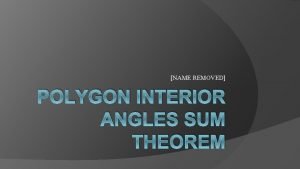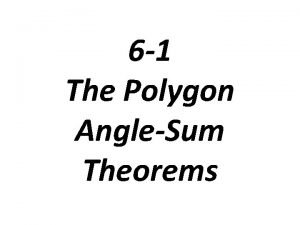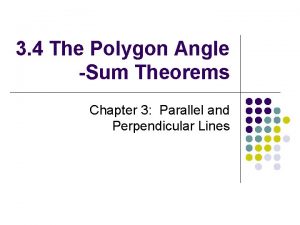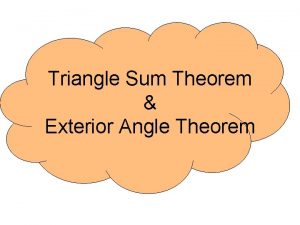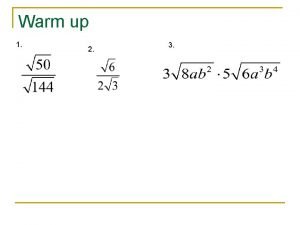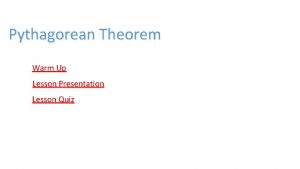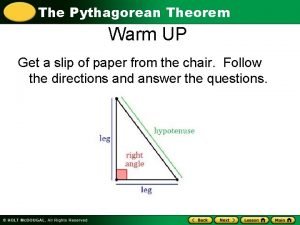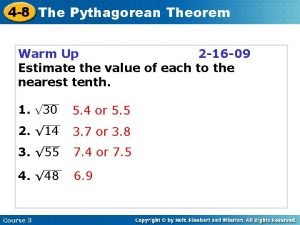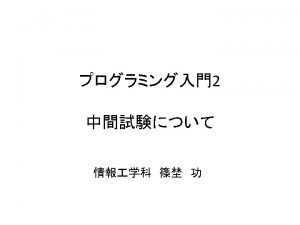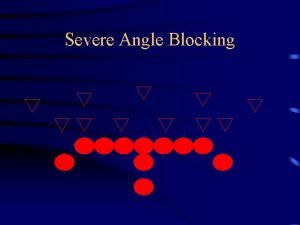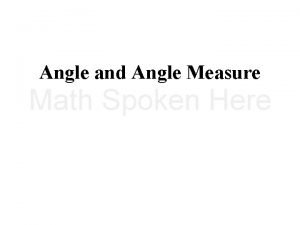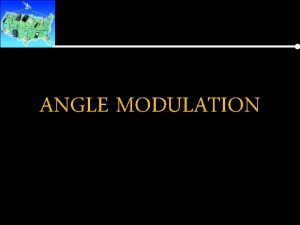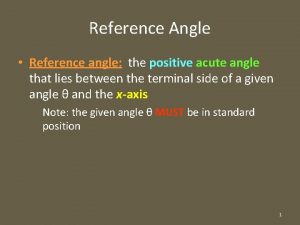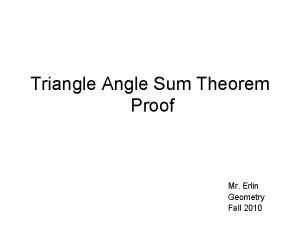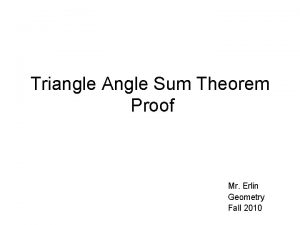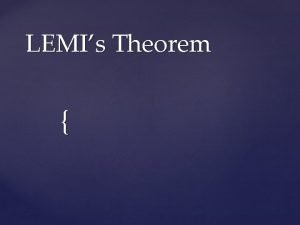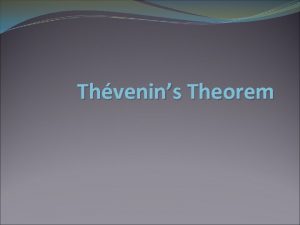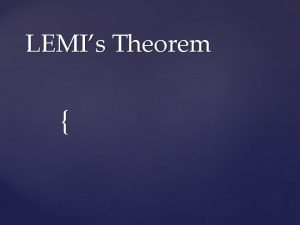Warm Up Angle Sum Theorem The sum of

















- Slides: 17

Warm Up Angle Sum Theorem The sum of the measures of the interior angles of a triangle is 180°. “a + b + c = 180 o” Given: The figure Prove: a + b + c = 180 o alternate interior b b a c alternate interior c

Lesson 2 -6 Write two-column proofs

Addition Property Definition of congruent seg. Subtraction Given Property Conclusion Definition of congruent <s Multiplication Property Definition of Linear Pair <s Division Property Definition of right <s Reflexive Property Definition of supplementary <s Symmetric Property Transitive Property • Definitions • Postulates Definition of complementary <s • Properties • Theorems Definition of angle bisector Substitution Property Segment addition postulate Distributive Property Angle addition postulate

Definition of congruent <s If “two angles are congruent”, then “they have the same measure” A D “m 40 o ABD = m DBC” 40 o B C Definition of Linear pair If “two angles form a linear pair”, then “they are supplementary” D “m 150 o A B 30 o C ABD + m DBC = 180 o”

Definition of right <s If “an angle is a right angle”, then “it measures 90 o” Definition of supplementary <s If “two angles are supplementary”, then “their sum is 180 o” Definition of complementary <s If “two angles are complementary”, then “their sum is 90 o” Definition of < bisector If “a ray bisects an angle”, then “it divides it into two equal halves” A 40 o 80 o 40 o B D “m C ABD = m DBC”

Given: <A and <B are supplementary and m<A = 45 o Prove: m<B = 135 o 45 o A Statements B Reasons 1) <A and <B are supplementary 1) Given 2) m<A = 45 o 2) Given 3) m<A + m<B = 180 o 3) Def. of supp. <s 4) 45 + m<B = 180 4) Substitution property 5) 45 + m<B – 45 = 180 – 45 5) Subtraction property 6) m<B = 135 o 6) Simplification

Given: <1 and <2 are complementary and m<1 = m<3 Prove: <3 and <2 are comp. 3 Statements 1 Reasons 1) <1 and <2 are complementary 1) Given 2) m<1 = m<3 2) Given 3) m<1 + m<2 = 90 o 2 3) Def. of comp. <s 4) m<3 + m<2 = 90 4) Substitution property 5) <3 and <2 are complementary 5) Def. of comp. <s

Given: <BAC is a right angle and m<2 = m<3 Prove: m<1 + m<3 = 90 o B 3 2 1 A Statements Reasons C 1) <BAC is a right angle 1) Given 2) m<2 = m<3 2) Given 3) m<BAC = 90 o 3) Def. of right. <s 4) m<1 + m<2 = m<BAC 4) Angle addition postulate 5) m<1 + m<2 =90 o 5) Substitution of step 3 in 4 6) m<1 + m<3 =90 o 6) Substitution of steps 2 in 5

Given: <2 <3 Prove: m<1 + m<3 = 180 o 1 Statements 1) <2 <3 2 3 Reasons 1) Given 2) m<2 = m<3 2) Definition of congruent <s 3) m<1 + m<2 = 180 o 3) Definition of Linear Pair 4) m<1 + <3 =180 o 4) Substitution of step 2 in 3

X Given: BX bisects <ABC and m<XBC = 45 o A Prove: m<ABC = 90 o 45 o B Statements C Reasons 1) BX bisects <ABC 1) Given 2) m<XBC = 45 o 2) Given 3) m<ABX = m<XBC 3) Def. of < bisector. 4) m<ABX = 45 o 4) Substitution property 5) m<ABX + m<XBC = m<ABC 5) Angle addition postulate 6) 45 o + 45 o = m<ABC 6) Substitution of steps 7) m<ABC = 90 o 7) Simplification & symmetric 2 & 4 in 5

Given: <1 and <2 are supplementary <3 and <4 are supplementary m<2 = m<3 Prove: m<1 = m<4 1 Statements 4 2 3 Reasons 1) m<1 + m<2 = 180 o 1) Definition of Supp. <s 2) m<3 + m<4 = 180 o 2) Definition of Supp. <s 3) m<1 + m<2 = m<3 + m<4 3) Substitution property 4) m<1 + m<3 = m<3 + m<4 4) Substitution property 5) m<1 = m<4 5) Subtraction property

Given: <BAC is a right angle & m<2 = m<3 Prove: m<1 + m<3 = 90 o B 3 2 1 A Statements Reasons C 1) <BAC is a right angle 1) Given 2) m<2 = m<3 2) Given 3) m<BAC = 90 o 3) Def. of right. <s 4) m<1 + m<2 = m<BAC 4) Angle addition postulate 5) m<1 + m<2 =90 o 5) Substitution of step 3 in 4 6) m<1 + m<3 =90 o 6) Substitution of steps 2 in 5

1 Statements 48 o Reasons 1) m<1 + 48 o = 180 o 1) Definition of linear pair 2) m<1 = 138 o 2) Subtraction property

(4 n + 5)o (8 n – 5)o Statements Reasons 1) 4 n + 5 + 8 n – 5 = 180 1) Definition of linear pair 2) 12 n = 180 2) Simplification 3) n = 15 3) Division

2 63 o Statements Reasons 1) m<2 + 63 o = 90 o 1) Definition of comp. <s 2) m<2 = 27 o 2) Subtraction property

4 x (3 x + 6)o Statements Reasons 1) 4 x + 3 x + 6 = 90 1) Definition of Comp. <s 2) 7 x + 6 = 90 2) Simplification 3) 7 x = 84 3) Subtraction 4) x = 12 4) Division

Two angles are complementary. The measure of one angle is 10 o less than the measure of the other angle. Find the measure of each angle. Statements Reasons 1) x + y = 90 o 1) Definition of comp. <s 2) x = y – 10 2) Translation 3) y – 10 + y = 90 o 3) Substitution 4) 2 y – 10 = 90 o 4) simplification 5) 2 y = 80 o 5) Addition property 6) y = 40 o 6) Division property 7) x = 50 o 7) Substitution property
 What is the triangle sum theorem
What is the triangle sum theorem 6-1 practice the polygon angle-sum theorems
6-1 practice the polygon angle-sum theorems 6-1 the polygon angle-sum theorems
6-1 the polygon angle-sum theorems The polygon angle sum theorem
The polygon angle sum theorem Angle sum theorem definition
Angle sum theorem definition Triangle sum and exterior angle theorem
Triangle sum and exterior angle theorem Define exterior angle theorem
Define exterior angle theorem Aa theorem
Aa theorem Green's theorem direction
Green's theorem direction Angle relationships warm up
Angle relationships warm up Topic 3 line and angle relationships answers
Topic 3 line and angle relationships answers Pythagorean theorem warm up
Pythagorean theorem warm up Pythagorean inequality theorem
Pythagorean inequality theorem Pythagorean theorem warm up
Pythagorean theorem warm up Pythagorean theorem warm up
Pythagorean theorem warm up 5-7 pythagorean theorem
5-7 pythagorean theorem Sum0
Sum0 Rewrite using a double-angle identity. a. b. c. d.
Rewrite using a double-angle identity. a. b. c. d.

